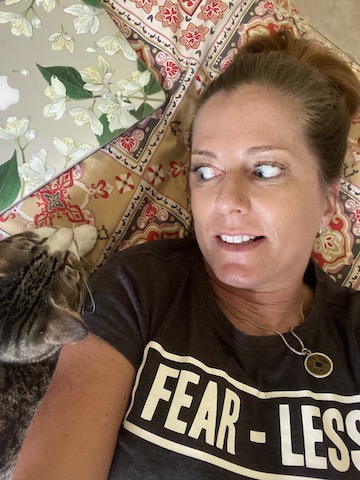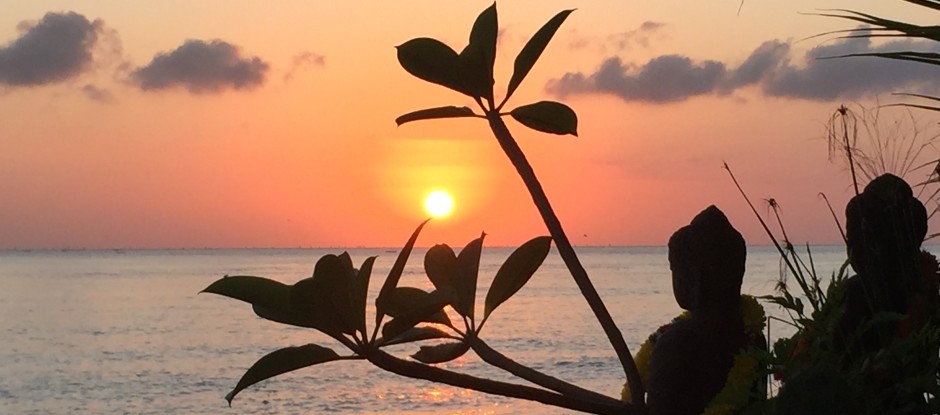March, 18, 2020.
I unlock my front gate and step out into the gravel street. I look to the right, uphill towards the rice fields. And then down and left, to the abandoned temple construction site. There is no one around. Though I’m relieved on the one hand about that, I’m also worried. I have no idea who has survived and who has not. I’ve heard birds and dogs in the streets in the last few weeks, but I have not heard any human voices. I’m not sure what has happened to my neighbors.
I turn around and lock my gate behind me. In my backpack I have a bottle of water (dirty, from the bore), what cash I put aside before the event, a useless credit card, my i.d., passport, and cell phone and charger – even though there is no service and the battery is dead. I have a small grubby towel, a toothbrush, and some soap. Of course, my face mask. I’m wearing my running shoes, long pants, a hoodie and a hat. I’m hoping to be mistaken for a little boy – that is, if I see anyone. My clothes are filthy – there’s been no electricity or water to wash clothes for as long as I can remember.
After weeks of rationing, I’ve just finished my last cans of tuna and beans. With no water or electricity, the rice and pasta I bought in preparation for this time is useless. I need to look for food before I get weak. I know I’m too thin, but I didn’t step on the scale before leaving my house. It’s just too depressing.
I walk down the hill towards the main road when I start to smell and see my neighbors. They are down on the ground, seemingly where they died. I don’t know if they died of the virus, of starvation, or of a combination of the two. Their houses look bombed-out and looted. I keep walking with my head down, only seeing what the brim of my hat doesn’t block.
The Pecalang see me walking down the hill and they motion for me to stop. I freeze in my tracks and raise my hands, not sure what to do next… I want to cry for joy that there are live humans around, but I’m not sure if I should also be afraid. They approach me…
On March 18th, Dixie State University history professor Jeremy C. Young tweeted:
The Imperial College team plugged infection and death rates from China/Korea/Italy into epidemic modeling software and ran a simulation: what happens if the US does absolutely nothing — if we treat COVID-19 like the flu, go about our business, and let the virus take its course?… Here’s what would happen: 80% of Americans would get the disease. 0.9% of them would die. Between 4 and 8 percent of all Americans over the age of 70 would die. 2.2 million Americans would die from the virus itself… It gets worse. People with severe COVID-19 need to be put on ventilators. 50% of those on ventilators still die, but the other 50% live. But in an unmitigated epidemic, the need for ventilators would be 30 times the number available in the US. Nearly 100% of these patients die. (https://www.oregonlive.com/coronavirus/2020/03/influential-coronavirus-pandemic-report-read-a-summary-of-the-staggering-projections-that-moved-us-government-to-act.html)
This projection was reported on a morning news show that I watch regularly. I kind of half-heard it on my way out the door to go to the gym, and it triggered me. Wow, did it TRIGGER me!
The scenario above sprung into my head on my ten-minute motorbike ride to the gym. If this virus could take down the US in this way, what could it do to the rest of the world? How might it affect my beloved Bali home? I am NOT a fearful person, and I don’t have apocalyptic ideations. In fact, that was my first and last.
Thankfully, I had been learning about and practicing some mind work, so I was able to back out of this ideation by entertaining the following questions and thoughts:
1) What is the chance of this REALLY happening? Pretty much zero.
2) If it were to happen would it be in one week? No. Two months? No. Six months? Maybe getting there. A year? Two years? …. okay, could POSSIBLY happen by then. But still not likely.
3) All I have to do is get through the next week or two. Then things will be clearer. Then I can stock up on what I need to, or not. Then I can make plans for the future…
I went and worked out for an hour, which always calms me down. But over the course of the next week I found myself creeping into pre-panic attack territory. Again, I used my new mind work skills, and I walked my way out and down.
In the days before Bali’s yearly day of silence, Nyepi, March 25 this year, the local government asked us to take an extra day after the holiday to stay home. To stay put not one day, but two.
Meanwhile, some Balinese gathered in very large pre-Nyepi ceremonies – of course photos of these were splashed all over social media. Some Banjars held only closed small prayer meetings. Local authorities were pretty much given license to govern their Banjars as they saw fit.
And many foreigners – both in and out of Bali – went CRAZY “predicting” that all those Balinese who had gathered together in prayer would be sick and would make the rest of us who live here sick in no time at all. “SHAMEFUL!” people yelled. “They need to do it like they are doing it in other countries!” “Just wait – you will see!!!” And we waited. And waited. And waited…
It’s now May 16th – two months after I first had that apocalyptic vision – and here are the statistics on COVID in Bali:
4 people have died
3 new cases today
346 total cases
243 recovered
Here again, critics say that the statistics are underreported because of lack of testing, and they are correct. But what’s been amazing to witness is how the local governance system in Bali has worked to mitigate this crisis.
But this is not my point.
Nyepi, our yearly day of silence, put me into a kind of calm space that’s difficult to describe. After feeling so worn out and fatigued for the two months before (I suspect I came back to Bali from Europe with a very mild case of the flu), I finally was feeling physically rested, and mentally at peace.
Being a natural introvert, spending time alone at home is not a new thing to me. Nor has it been a hardship. Here in Bali we have a lot of freedom to move around and do our daily activities. Social distancing has been suggested since March, as have masks and vigilance about hand hygiene. These measures have been mandated more and more as the desa asli (original villages) of Bali move to protect their villagers as well as the foreigners who live therein. There is limited movement between other islands and Bali, and into Indonesia from other countries. However, the return of Indonesian workers from overseas has resulted in quarantines (some effective, a few not) and a few new cases. Every day there are a couple of “local transmissions” of COVID as well. But none of the doom and gloom predictions for our island have come to fruition. The nay-sayers STILL bang on, “Just wait!!!” And we do.
I’ve used this time to calm my brain. The peace of Bali is as I would imagine it was 30 years ago, before mass-tourism arrived. (I could describe the decimation of the local economy that’s happening, but that’s something for another time…) Birds are singing. The skies are BRIGHT blue, as air pollution has been all but eliminated. Traffic is a dream.
The Balinese are worried, but not panicked. Indonesians from other islands who are still in Bali are maybe a bit more worried, being far from home and their families, but again, they are not panicked.

I was “warned” by my government to return “home” when the pandemic was declared. But Bali IS my home. Where am I to go? Who will care for my animals? What about my life and business in Bali? When might I be able to return?
I chose to stay put, and so far I’m very happy with that choice. I feel safe; I’m involved in a small effort to provide food relief to locals; I’m keeping an eye on my business (optimistically re-scheduling weddings for next year); and fostering kittens.
What is actually going on here with this pandemic? What exactly is COVID? What is the “proper” way for governments and the world to react to it? When and how might we move out and forward from this crisis? There are so many questions. And yet the only truth is that time will tell.

